Main Difference
The main difference between Destroyer and Battleship is that the Destroyer is a fast and maneuverable escort warship and Battleship is a large armored warship with a main battery consisting of heavy caliber guns.
-
Destroyer
In naval terminology, a destroyer is a fast, maneuverable long-endurance warship intended to escort larger vessels in a fleet, convoy or battle group and defend them against smaller powerful short-range attackers. They were originally developed in the late 19th century as a defence against torpedo boats, and by the time of the Russo-Japanese War in 1904, these “torpedo boat destroyers” (TBDs) were “large, swift, and powerfully armed torpedo boats designed to destroy other torpedo boats.” Although the term “destroyer” had been used interchangeably with “TBD” and “torpedo boat destroyer” by navies since 1892, the term “torpedo boat destroyer” had been generally shortened to simply “destroyer” by nearly all navies by the First World War.
Before World War II destroyers were light vessels with little endurance for unattended ocean operations; typically a number of destroyers and a single destroyer tender operated together. After the war, the advent of the guided missile allowed destroyers to take on the surface combatant roles previously filled by battleships and cruisers. This resulted in larger and more powerful guided missile destroyers more capable of independent operation.
At the start of the 21st century, destroyers are the global standard for surface combatant ships, with only two nations (United States and Russia) operating the heavier class cruisers, with no battleships or true battlecruisers remaining. Modern guided missile destroyers are equivalent in tonnage but vastly superior in firepower to cruisers of the World War II era, and are capable of carrying nuclear tipped cruise missiles. At 510 feet (160 m) long, a displacement of 9200 tons, and with armament of more than 90 missiles, guided missile destroyers such as the Arleigh Burke-class are actually larger and more heavily armed than most previous ships classified as guided missile cruisers.
Some European navies, such as the French, Spanish, or German, use the term “frigate” for their destroyers, which leads to some confusion.
-
Battleship
A battleship is a large armored warship with a main battery consisting of large caliber guns. During the late 19th and early 20th centuries the battleship was the most powerful type of warship, and a fleet of battleships was considered vital for any nation that desired to maintain command of the sea.
The word battleship was coined around 1794 and is a contraction of the phrase line-of-battle ship, the dominant wooden warship during the Age of Sail. The term came into formal use in the late 1880s to describe a type of ironclad warship, now referred to by historians as pre-dreadnought battleships. In 1906, the commissioning of HMS Dreadnought heralded a revolution in battleship design. Subsequent battleship designs, influenced by HMS Dreadnought, were referred to as “dreadnoughts”, though the term eventually became obsolete as they became the only type of battleship in common use.
Battleships were a symbol of naval dominance and national might, and for decades the battleship was a major factor in both diplomacy and military strategy. A global arms race in battleship construction began in Europe in the 1890s and culminated at the decisive Battle of Tsushima in 1905, the outcome of which significantly influenced the design of HMS Dreadnought. The launch of Dreadnought in 1906 commenced a new naval arms race. Three major fleet actions between steel battleships took place: the decisive battles of the Yellow Sea (1904) and Tsushima (1905) during the Russo-Japanese War, and the inconclusive Battle of Jutland (1916) during the First World War. Jutland was the largest naval battle and the only full-scale clash of battleships in the war, and it was the last major battle fought primarily by battleships in world history.
The Naval Treaties of the 1920s and 1930s limited the number of battleships, though technical innovation in battleship design continued. Both the Allied and Axis powers built battleships during World War II, though the increasing importance of the aircraft carrier meant that the battleship played a less important role than had been expected.
The value of the battleship has been questioned, even during their heyday. There were few of the decisive fleet battles that battleship proponents expected, and used to justify the vast resources spent on building battlefleets. Even in spite of their huge firepower and protection, battleships were increasingly vulnerable to much smaller and relatively inexpensive weapons: initially the torpedo and the naval mine, and later aircraft and the guided missile. The growing range of naval engagements led to the aircraft carrier replacing the battleship as the leading capital ship during World War II, with the last battleship to be launched being HMS Vanguard in 1944. Battleships were retained by the United States Navy until the end of the Cold War for fire support purposes and were last used in combat in this role during the Gulf War in 1991. The last battleships in commission were stricken from the U.S. Naval Vessel Register in the 2000s.
-
Destroyer (noun)
That which destroys something.
-
Destroyer (noun)
A small, fast warship with light armament, smaller than a cruiser, but bigger than a frigate.
-
Battleship (noun)
Large capital warship displacing tens of thousands of tons, heavily armoured and armed with big guns. Battleships are now obsolescent, replaced by smaller vessels with guided missiles. Types: dreadnought, pre-dreadnought.
-
Battleship (noun)
Non-functional rocket stage, used for configuration and integration tests.
-
Battleship (noun)
A guessing game played on grid paper, see Battleship (game)
-
Destroyer (noun)
a small, fast warship, especially one equipped for a defensive role against submarines and aircraft.
-
Destroyer (noun)
a person or thing that destroys something
“CFCs are the chief destroyers of the ozone layer”
-
Battleship (noun)
a heavy warship of a type built chiefly in the late 19th and early 20th centuries, with extensive armour protection and large-calibre guns.

